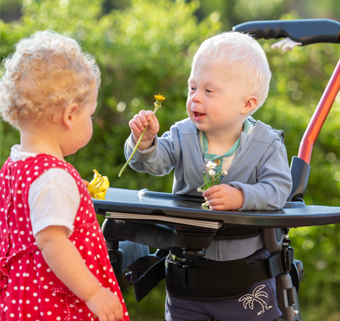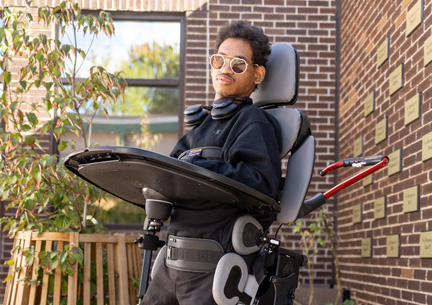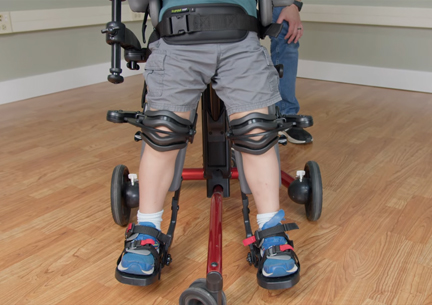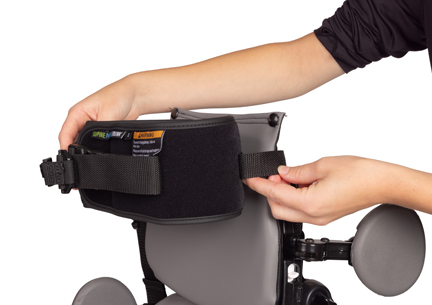Guidelines for Functional Use of the Rifton Mobile Stander
| March 2013As its name suggests, the Rifton Mobile Stander combines all the benefits of mobility with a supportive standing frame. It is far more than prone or supine standers which are passive positioning devices. It is also more than an upright wheelchair. Using the prompts of the mobile stander correctly can improve an individual’s standing ability and, through movement, effectively challenge their balance and stability boundaries.
Even children who are low-tone or dependent can be helped to gain the weight-bearing and postural control needed for standing. The adjustability of the Mobile Stander allows for prompt reduction and removal. In this way, many children are able to achieve virtually independent standing.
The benefits of standing include improved bone density, prolonged stretch for tight muscles at hips, knees, and ankles, and improved function of the pulmonary, respiratory and digestive systems. There are also immeasurable social benefits for a child who is at the same level as his peers. With opportunity and practice, the child’s ability to participate in activities of daily living expands. Independent mobility can improve spatial awareness and may even stimulate language gains. Finally, and perhaps most importantly, independent mobility and choice making positively affect cognitive growth.
 Body Support: The body support is comfortably padded and is in a slightly forward-leaning position. The height is adjustable, to maximize support up to the nipple level of the child. Heavier children are accommodated by the width adjustment. In the Mobile Stander, the child is encouraged to develop active head control and upper trunk strength.
Body Support: The body support is comfortably padded and is in a slightly forward-leaning position. The height is adjustable, to maximize support up to the nipple level of the child. Heavier children are accommodated by the width adjustment. In the Mobile Stander, the child is encouraged to develop active head control and upper trunk strength.
Seat Pad: The Mobile Stander comes with one seat pad, usually placed at an angle under the child’s seat, to assist weight bearing. The seat pad is available in two sizes, and it attaches with four independently adjustable straps onto multiple hook options. The seat pad can be adjusted up and down and angled in a variety of ways. For the non-weight-bearing child, the seat pad can be fixed horizontally (like a chair seat), taking all the weight off the child’s legs. In this case, an additional seat pad can be used against the lower back, providing extra support. This configuration can also be used for a child with hip or knee contractures by adjusting the angles of the seat pads to accommodate the degrees of flexion.
 Reverse Position: If a child actively extends their hips and knees in full weight-bearing, they can progress to the reverse position. With the body support at the back, the child’s postural control is challenged. In some cases, two seat pads are used: one supports the knees, while the other can support the trunk. Even children with significant scoliosis or lordosis can be positioned in this manner. It is a great position for strengthening the trunk and stretching out tight hip flexor muscles.
Reverse Position: If a child actively extends their hips and knees in full weight-bearing, they can progress to the reverse position. With the body support at the back, the child’s postural control is challenged. In some cases, two seat pads are used: one supports the knees, while the other can support the trunk. Even children with significant scoliosis or lordosis can be positioned in this manner. It is a great position for strengthening the trunk and stretching out tight hip flexor muscles.
Fleece Strap: The soft fleece strap can be used for upper back support or even for head control. For children with low tone, placed with their front against the body support, this fleece can be placed under one armpit and over the opposite shoulder and tightened snugly to support the upper back. With children demonstrating improved ability, or when minimal support is required, the fleece can be positioned more loosely straight across the upper back. It is also possible to set the fleece strap up behind a child’s neck for a child who perpetually hyperextends the head and neck while standing.
Knee Strap: The knee straps adjust up and down in vertical slots on the body support to secure the legs in extension, and provide abduction if needed, without compromising development of the child’s weight-bearing potential.
 Arm Prompts: The arm prompts allow for shared weight-bearing through the upper extremities and are a key asset for promoting head, shoulder, and trunk control. The arm prompts can be angled up or down, or rotated in and out as needed to allow for customized positioning. Many have found that for a child with low tone, having these prompts angled forward and upward will help stimulate them to lift up their heads. For a child with high extension tone, having the prompts angled downward can help bring them forward into flexion. With the added arm prompts, the Mobile Stander can be effective as a standing practice device, rather than mobility equipment.
Arm Prompts: The arm prompts allow for shared weight-bearing through the upper extremities and are a key asset for promoting head, shoulder, and trunk control. The arm prompts can be angled up or down, or rotated in and out as needed to allow for customized positioning. Many have found that for a child with low tone, having these prompts angled forward and upward will help stimulate them to lift up their heads. For a child with high extension tone, having the prompts angled downward can help bring them forward into flexion. With the added arm prompts, the Mobile Stander can be effective as a standing practice device, rather than mobility equipment.
 Accessibility: When the large wheels of the Mobile Stander are removed, the child can scoot up close to easels, sinks, tables, and computers—places otherwise unreachable from wheelchairs or other standers. This opens up opportunities for social interaction and participation; children simultaneously practice weight shifting, balance, and postural control as they interact and play. The wide, low foot platform makes it easy to transfer the student in and out of the Mobile Stander. Sandals and wedges can be positioned to accommodate leg length discrepancies or ankle contractures while the child stands.
Accessibility: When the large wheels of the Mobile Stander are removed, the child can scoot up close to easels, sinks, tables, and computers—places otherwise unreachable from wheelchairs or other standers. This opens up opportunities for social interaction and participation; children simultaneously practice weight shifting, balance, and postural control as they interact and play. The wide, low foot platform makes it easy to transfer the student in and out of the Mobile Stander. Sandals and wedges can be positioned to accommodate leg length discrepancies or ankle contractures while the child stands.
 Mobility: When the large wheels are in place, the Mobile Stander becomes a vehicle for independent movement. The hand rims on the large wheels allow children to self-propel. This encourages weight shifting, improved strength, range of motion, balance and righting responses. The big casters and large wheels can accommodate level outdoor surfaces. The locks on the large wheel can be reached and operated by children with good hand use, or by the caregiver. Gym teachers love how the Mobile Stander allows children to participate in many games and sports.
Mobility: When the large wheels are in place, the Mobile Stander becomes a vehicle for independent movement. The hand rims on the large wheels allow children to self-propel. This encourages weight shifting, improved strength, range of motion, balance and righting responses. The big casters and large wheels can accommodate level outdoor surfaces. The locks on the large wheel can be reached and operated by children with good hand use, or by the caregiver. Gym teachers love how the Mobile Stander allows children to participate in many games and sports.
Tips for Adjusting the Mobile Stander for Functional Improvement
- Remove arm prompts once child has sufficient strength to maintain head and upper body control using only the body support, seat pad, and soft fleece strap.
- Adjust the horizontal angle of the seat pad to a more vertical position against the pelvis and lower back as children begin to take weight through their lower extremities. li>
- Lower the body support from nipple down towards waist level as the child establishes upper trunk stability.
In time, children may be able to bear their own weight without the stander. With some hands-on support for balance, or by leaning against a table or wall, further progression towards independent standing can be made. Also by this time, many children are participating in walking activities as well, using a Rifton Pacer or similar gait-training device.




